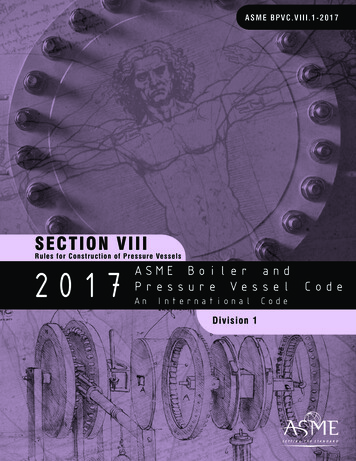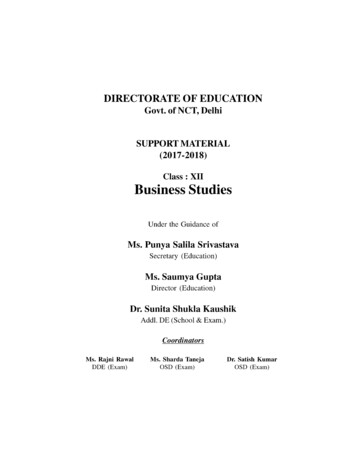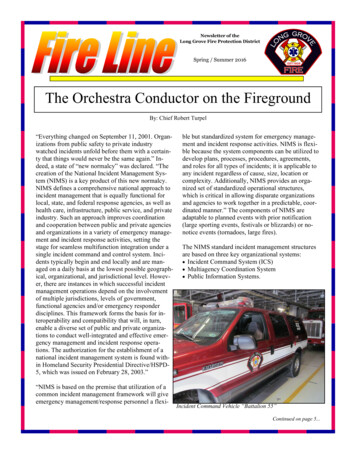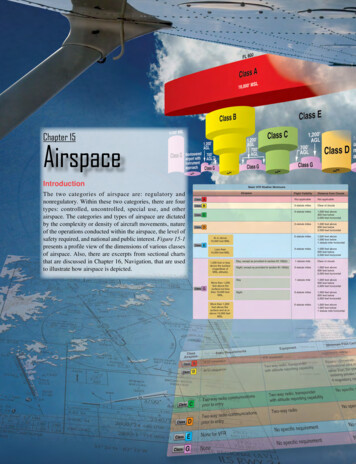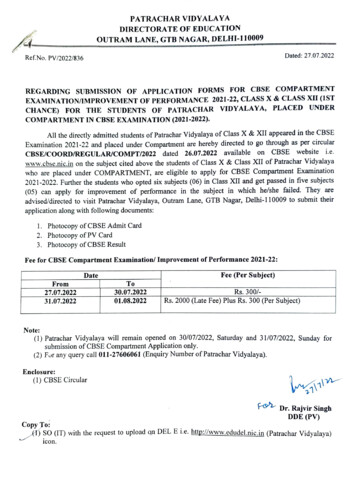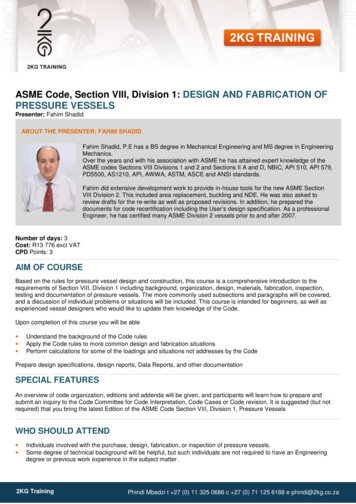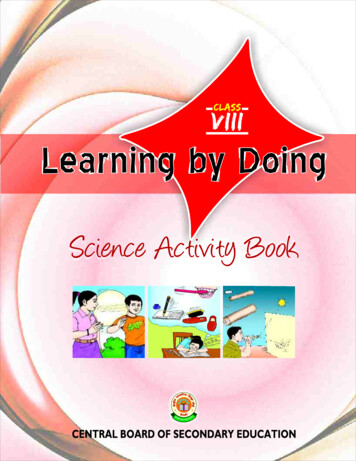
Transcription
CLASSviiiLearning by DoingScience Activity BookCENTRAL BOARD OF SECONDARY EDUCATIONPREET VIHAR, DELHI - 110092
Learning by Doing, Science Activity Book for Class 8thPRICE : Rs. 50.00FIRST EDITION 2009 CBSE, IndiaCOPIES : 25,000PUBLISHED BY: The Secretary, Central Board of Secondary Education, Shiksha Kendra,2, Community Centre, Preet Vihar, Delhi - 110092DESIGN, LAYOUT &ILLUSTRATIONS BY: Multi Graphics, 5745/81, Reghar Pura, Karol Bagh, New Delhi - 110092.Phone : 25783846PRINTED BY: Vijayalakshmi Printing Works (P) LimitedB-117, Sector-5, Noida,-201301, Ph.: 0120-2421763, 2421977
ForewordScience is being taught is school in a very mechanical way. Students are confined to their textbooks, thetopics and contents included therein. They are hardly encouraged to observe, explore, look forpatterns or analyse the everyday experience occurring around them. Mere rote memorization ofconcepts is leading children towards a stressful existence. NCF 2005 aptly says, "The fact that learninghas become a source of burden and stress on children and their parents is an evidence of a deepdistortion in educational aims and quality". To correct this, the NCF has proposed five guidingprinciples. Some of these are;i)ii)connecting knowledge to life outside schoolensuring that learning shifts away from rote methods.The present document "Learning by doing" is an effort by the Board to make Science learing moremeaningful, interesting and joyful. This document is in continuity to our earlier documents for classesVI and VII brought out in preceding years. An effort has been made to include activities which are basedon different content areas and concepts given in NCERT textbook in Science for class VIII. It is hopedthat after performing these activities, students will be able to understand the concepts better,internalize them and will be motivated to create more such experiences. Wide variety of activitiesincluding observation, exploration, analysis, games, riddles, crossword puzzles etc. have been includedto meet diverse needs of learners and help them appreciate and enjoy the learning experiences. Thesuggested activities have been so designed that they can be done easily without using expensivematerials or equipment.I take this opportunity to put on record my sincere and heartfelt thanks to all the members of thedevelopment and editorial team for sparing their valuable time and extending their expertise infinalization of this document. My deep appreciation and thanks are due to Smt. C. Gurumurthy,Director (Acad.), CBSE for providing guidelines and directions at different stages of preparation of thisdocument. Dr. (Mrs.) Srijata Das, Education Officer, CBSE deserves special mention and appreciationfor putting in her honest efforts in perceiving, coordinating and completing the documents in time.It is hoped that all the schools and Science teachers would use this document in right spirit andencourage the students to perform these activities and learn by doing rather than rote memorization.In its endeavour for continuous improvement the Board welcomes observations, comments andsuggestions from the users.Vineet JoshiChairmani
AcknowledgementsCBSE Advisors:Sh. Vineet JoshiChairmanSmt. C. GurumurthyDirector AcademicMaterial Developmental Team:Dr. V.P. SinghState Project Director, UEE MissionMrs. VidhuNarayananTeacher, Sardar Patel Vidyalaya, Lodhi Estate, New DelhiMrs. K. SyamalaTeacher, Sardar Patel Vidyalaya, Lodhi Estate, New DelhiMrs. Shivani Goswami1-1756, CR Park, New DelhiMrs. Soma SinghTeacher, Delhi Public School, GhaziabadMrs. Neelam BatraTeacher, D.C. Arya Sr. Secondary School, Lodhi Road,New DelhiEditorial TeamSh. S.K. MunjalPrincipal, St. Margaret School, Rohini, DelhiSh. C.B. VermaRetd. Principal, D.C. Arya Sr. Secondary School, LodhiRoad, New DelhiDr. Subhasri SinhaSr. Lecturer, SCERT, Defence Colony, New DelhiMrs. Vidhu NarayananTeacher, Sardar Patel Vidyalaya, Lodhi Estate, New DelhiMrs. SangeetaTeacher, St. Margaret School, Rohini, DelhiMember Coordinator:Dr. Srijata DasEducation Officer, CBSE, Delhiii
Hkkjrdklafo/kumísf'kdkge]Hkkjrdsyksx]Hkkjrdks,d ¹lEiw.kZizHkqRo&laiUulektoknhiaFkfujis{kyksdra kkRedx.kjkT;ºcukusdsfy,]rFkkmldsleLrukxfjdksa r]fo'okl]/eZvkSjmiklukdhLora f'prdjusokyhca/qrkc kusdsfy,n ladYigksdjviuhbllafo/kulHkkesa vktrkjh[k26uoEcj]1949bZñdks,rn gSaA21- 311977)ls¶izHkqRo&laiUuyksdra kkRedx.kjkT; dsLFkkuijizfrLFkkfirA2- 311977ls)]¶jk"Vªdh,drk kSjjk"Vªxkudkvknjdjs([k)Lora kn'kksZa dksân;esa svkSjvkg okufd,tkusijjk"Vªdhlsokdjs(Ä)HkkjrdslHkhyksxksa esa lejlrkvkSjlekuHkzkr ijvk/kfjrlHkhHksnHkkolsijsgksa],slhizFkkvksa dkR;kxdjstksfL k;ksa hijaijkdkegÙole rou] zkf.kek kdsizfrn;kHkkoj[ks(t)oSKkfudn ldjs( )lkoZtfudlaifÙkdkslqjf{krj[ksvkSjfgalklsnwjjgs( k)O;fDrxrvkSjlkewfgdxfrfof/;ksa dslHkh{ks kksa esa mRd"kZdhvksjc usdklrriz;kldjsftllsjk"Vªfujarjc rsgq,iz;RuvkSjmiyfC/dhubZmapkb;ksa dksNwysAiii
THE CONSTITUTION OF INDIAPREAMBLEWE, THE PEOPLE OF INDIA, having solemnly resolved to constitute India into a SOVEREIGNSOCIALIST SECULAR DEMOCRATIC REPUBLIC and to secure to all its citizens :1JUSTICE, social, economic and political;LIBERTY of thought, expression, belief, faith and worship;EQUALITY of status and of opportunity; and to promote among them allFRATERNITY assuring the dignity of the individual and the [unity and integrity of the Nation];2IN OUR CONSTITUENT ASSEMBLY this twenty-sixth day of November, 1949, do HEREBY TOOURSELVES THIS CONSTITUTION.1.2.Subs, by the Constitution (Forty-Second Amendment) Act. 1976, sec. 2, for "Sovereign Democratic Republic (w.e.f. 3.1.1977)Subs, by the Constitution (Forty-Second Amendment) Act. 1976, sec. 2, for "unity of the Nation (w.e.f. 3.1.1977)THE CONSTITUTION OF INDIAChapter IV AFundamental DutiesARTICLE 51AFundamental Duties - It shall be the duty of every citizen of India(a) to abide by the Constitution and respect its ideals and institutions, the National Flag and the NationalAnthem;(b) to cherish and follow the noble ideals which inspired our national struggle for freedom;(c)to uphold and protect the sovereignty, unity and integrity of India;(d) to defend the country and render national service when called upon to do so;(e) To promote harmony and the spirit of common brotherhood amongst all the people of Indiatranscending religious, linguistic and regional or sectional diversities; to renounce practicesderogatory to the dignity of women;(f)to value and preserve the rich heritage of our composite culture;(g) to protect and improve the natural environment including forests, lakes, rivers, wild life and to havecompassion for living creatures;(h) to develop the scientific temper, humanism and the spirit of inquiry and reform;(i)to safeguard public property and to abjure violence;(j)to strive towards excellence in all spheres of individual and collective activity so that the nationconstantly rises to higher levels of endeavour and achievement.iv
ContentsACTIVITIESPAGE NO.ACTIVITIESForwardIntroductionFORCE AND PRESSURE1LIGHTMAKE YOUR LITTLE MOVIE3LIGHTMAKE A PERISCOPE6SOUNDSUNO! SUNO!9SOUNDLET'S MAKE MUSIC11SOUNDI CAN SEE MY SOUND!15SOUNDHOW DOES SOUND TRAVEL?17STARS AND THE SOLAR SYSTEMIS THE MOON GROWING OR SHRINKING ?19STARS AND THE SOLAR SYSTEMMAKING A SOLAR SYSTEM MOBILE22LIGHTI CAN SEE IT, I CANNOT !24FORCE AND PRESSUREEGG POPS INTO A BOTTLE26FORCE AND PRESSUREA FORCEFUL STORY28SOME NATURAL PHENOMENAWANT TO BE A SNAKE CHARMER?30FRICTIONTHE BALL BEARING32PAGE NO.MATERIALS - METALS AND NON- METALSLIGHTER OR HEAVIER?43CHEMICAL EFFECTS OF CURRENTWHAT MAKES WATER?45COMBUSTION AND FLAMEA Surprising Fact47SYNTHETIC FIBRES AND PLASTICSINTERVIEW FOR MAKING MERIT LIST49POSTER MAKINGSYNTHETIC FIBRES AND PLASTICS52CROP PRODUCTION AND MANAGEMENTPITCHER POWER54CROP PRODUCTION AND MANAGEMENTJUST FOR FUN56CROP PRODUCTION AND MANAGEMENTBACK TO THE EARTH58MICRO ORGANISMS : FRIEND AND FOEA MOULDY PARTY60MICRO ORGANISMS : FRIEND AND FOESPORE MAGIC63MICRO ORGANISMS : FRIEND AND FOEA FRIEND INDEED65CONSERVATION OF PLANTS & ANIMALSA TREE STUDY68CONSERVATION OF PLANTS & ANIMALSWINDOW TO OUR RICH BIODIVERSITY70CELL-STRUCTURE & FUNCTIONSINSIDE STORY75REPRODUCTION IN ANIMALSSTORY OF GRANNY AND HER CHILDREN77FRICTIONTHE TUG OF WAR3579SOME NATURAL PHENOMENAMYSTERIOUS FORCESREPRODUCTION IN ANIMALSSTAGES OF HUMAN REPRODUCTION37REACHING THE AGE OF ADOLESCENCEPLEASE HEAR WHAT I AM NOT SAYING82REACHING THE AGE OF ADOLESCENCEDELIGHTFUL DAYDREAMS84REACHING THE AGE OF ADOLESCENCEGROWING UP86COAL AND PETROLEUMITS CO2 AGAIN39COAL AND PETROLEUMTHE PUZZLING LETTERS41MATERIALS - METALS AND NON- METALSBRING BACK THE SHINE42v
IntroductionScience is a dynamic, expanding body of knowledge. It involves observing, exploring,hypothising, verifying, analyzing and interpreting various phenomena occurring around us.It is common knowledge that except few, hardly does any Science teacher encourages astudent to go beyond the content and concepts given in the textbook. This is making thesubject boring and dull.Science can be made lively and interesting by giving students hands on experiences and byencouraging them to ask questions, observe, explore, experiment and investigate. Learningshould not remain confined to the classroom alone but it should be intricately woven intothe experience of the daily lives of the students. This document "Learning by Doing" forclass VIII is aimed at meeting some of these aspirations and expectations of the subject.The activities included in this document are based on the content/concepts given in NCERTtextbook in Science for class VIII. Effort has been made to keep the activities very simpleeasy to perform with minimum cost involvement. The activities are of different typesinvolving observation, exploration, experimentation, investigation. Some of the activitiesare in the form of riddles, games and puzzles.It is hoped that students and teachers will use this book in the right spirit and pave the wayfor better teaching-learning process in Science.Dr. Srijata DasEducation Officer, CBSE, Delhivi
&FORCEPRESSURE1THE STORY OFMAGDEBERG HEMISPHERELong Time ago there was a man called Otto von Guerick who lived in the town of Magdeberg in Germany.One day he invited everyone in the town to come and watch a spectacular event. All the people who cameto watch were very impressed with what he had done. Do you want to know what happened? He took twolarge copper hemispheres that fitted together. He pumped out air from in between these twohemispheres. He then tied sixteen horses, eight on each side of the hemispheres. But what was sospectacular about this? However hard they were made to pull, the horses were unable to pull thehemisphere apart! But as soon as Mr. Guerick allowed air into the sphere again, the hemispheresseparated. Isn't that wonderful?Many of you must be wishing that if only you had horses, rope and copper hemispheres to try it out again.Well! You don't need all these. You can repeat the Magdeberg experiment with very simple things too!You will need: Two tins of the same size, filter paper, scissors, water, strips of paper and matchbox.What to do: Take two tins of the same size.Estimate the diameter of the mouth ofthe tin.Cut out a circle from the filter paper thathas a diameter slightly larger than thediameter of the mouth of the tins.Draw a circle of radius about 2cm lessthan the radius of the circle cut outearlier.Cut along the inner circle so as to make ahole. (fig.1)Wet this filter paper circle by justdipping it in water. Now place it on top ofone of the tins. (fig.2)Burn a few strips of paper and drop themin the same tin.Quickly place the second tin on the firstso that the mouths of the two tins areone above the other and the circularsheet of paper is in between the twotins. (fig.3)Now pick up the upper tin. What do youfind? Does the lower tin also follow theupper one? Do they seem glued together?Fig. 11
FORCE&PRESSUREFig. 2THE STORY OF MAGDEBERG HEMISPHEREFig. 3Fig. 4I have learnt:The burning paper heats the air inside the tin. When air is heated, it expands and some of it escapes out ofthe tin. When the flame goes out, the air inside the tin cools and contracts, which takes up less space.This creates a low pressure inside the tin than outside. The greater pressure outside the tin keeps themglued.Something more for you to think about:You have learnt that air exerts pressure. Then why is it that we don't feel the pressure of air around uson our bodies?2
LIGHT2MAKE YOUR LITTLE MOVIENayana: Ha! Ha! Ha!Nayana was reading a newspaper article and laughing loud.Palak (Nayana's sister) : What is the joke? Share it with me too.Nayana:According to this article, in the 1890s when movies were new, people sometimes ran screaming fromtheatres when pictures of moving vehicles or ocean waves seemd to come at them on the screen.Palak:These looked like the real thing to them and they did not understand what was happening. Today, weknow a movie isn't real. Its just a series of pictures that are made to move fast. Each picture on a movie orcartoon filmstrip is slightly different from the one before and after it. When the film is projected, allthose images go by so fast you never get a chance to see each one separately before the next one comesalong. Instead your eyes and brain “hang on” to each image for a moment, making all the pictures mergetogether in what looks like continous motion. This effect is called 'persistence of vision'.Come let's make our own mini movie.You will need: A piece of paper 20cm by 8cm.3
LIGHTMAKE YOUR LITTLE MOVIEWhat to do: Fold the paper in half so that it looks like a four page booklet. Insert a carbon paper in this booklet. Now draw eyes without eyeballs and smiling mouth on the top sheet as shown. Remove the carbon paperDraw the eye balls looking to the right on the top sheet and the eye balls looking to the left in thelower sheet as shown in the picture. Roll the top sheet tightly around a pencil.Move the pencil up and down quickly so that the top sheet rolls up and unrolls quickly on its own.Think of more such actions that can be shown in two simple pictures and share these mini movieswith your friends.4
LIGHTMAKE YOUR LITTLE MOVIELet us try something more challenging.Make your flip bookYou will need: a small notebook, a sketch pen.What to do: First of all you must decide on a sequence of pictures, for example, a bouncing ball, arunning horse or a moving clock.The book consists of a series of sequential pictures put on a separate sheet of paper, one after the other.When the book is flipped through, the pictures provide the illusion of a moving picture.5
LIGHT3MAKE A PERISCOPEJames is very excited today. He is at the dockyard where his father works. His father had promised him toshow the ships and submarine, if James stood first in class for his final exam. James did not know of thesurprise that was waiting for him. His father had taken special permission to allow both of them to see theinteriors of a submarine. James could not help but shriek in excitement when his father took himunderwater inside a submarine.'I don't feel as if I am under the water surface, said James.'Come, have a look at this, said father pointing to an instrument.James looked through it and was delighted to see the objects above water. He could not believe his eyes.He could see the land around. He could see people walking around in the dockyard. I know this is aperiscope, said James, who had read about it in books.Seeing James so excited, father promised him that he will help make a periscope of his own.When they got back home, both James and his father got down to making a periscopeSo, roll up your sleeves, and get going!! Make your own periscope.You will need: Cardboard pencil box, or any other similar box, two rectangular mirrors, cello tape, papercutter, scissors.What to do: Mark 2.5cm from each end of the box. Cut three sides only (one big and two small) at these ends.Bend the cuts at right angles as shown.Attach the mirrors using cellotape where the box has been bent.6
LIGHT MAKE A PERISCOPEThis should be done in such a manner that the mirror surfaces are facing the box at right angles. *Ensure that both the bent parts of the pencil box are at right angles. You may attach a piece ofcellotape for this.Now hold the periscope vertical and peep through the lower rectangular window. Are you able tosee objects located at a higher level? How is that possible?MirrorObjectMirrorA periscope like the one you have made uses two mirrors. Look at the diagram of a periscope shown here.The mirrors are placed so that one mirror reflects the light from the object onto a second mirror. Thesecond mirror then reflects the light beam to your eyes.7
LIGHTMAKE A PERISCOPERay diagram of a periscope.A periscope is commonly used in submarines. The captain of the submarine uses it to see what happensabove water and to detect enemies.So now what are you waiting for? Get ready to peak around corners, over the fence and over tabletopsand surprise your friends. HAVE FUN!8
SOUND4SUNO! SUNO!“Suno! Suno! Can you all hear me?', shouted Nilu. 'If you shout like this the whole world can hear you', saidDidi. 'I just wanted to feel my vocal chords vibrating. Our teacher told us that the vibration of vocal cordsin our throat allows us to make sound. You are able to hear me because these vibrations from my mouthare then passed to you through air. I wish I could see these vibrations. ' said Nilu, a little disappointed.'Sometimes you cannot see them, but you can see their effect through these activities', said Didi.Feel the vibrationsYou will need: a balloon and a friendWhat to do:1. Blow up the balloon.2. Hold it against your ear.3. Ask your friend to press his/her lips against the balloon and speak.You can hear the vibrations through the balloon and can feel them. One can feel his/her own voicethrough his/her lips as the balloon's skin vibrates creating sound waves.9
SOUNDSUNO! SUNO!See the effect of vibrationsYou will need:a colourless polythene packet, a wide mouth tin can, a rubber band or string, a few grains of puffed rice,a metal tray or a steel vessel, a wooden stick or ruler.What to do:1.2.3.4.5.Cut the polythene packet and stretch it over the open mouth of the can.Use the rubber band to hold the polythene in place.Place few puffed rice on the polythene.Hold the metal tray or the steel vessel near the can.Tap it hard with a wooden stick or ruler. What happens to the rice grains?The metal tray vibrates when it is hit with the ruler. These vibrations make the air around it vibrate too.The vibrations pass through air and make the stretched polythene start vibrating as well. This makes thepuffed rice move.I Have LearntSound is created when an object moves and the air around it vibrates creating sound waves.DO YOU KNOW?When you cup your ears with your palm, you hear a dull roaring sound. That's the echo of the bloodmoving in your ear.10
SOUND5LET'S MAKE MUSIC“Well, that's the end of the lesson on sound. I hope everyone has understood the chapter, said Mr. Tarang,the science teacher. I have a wonderful idea to test how well you have understood the lesson, continuedMr. Tarang. Now that you have learnt the properties of sound, create your own musical instrument. Workcarefully and try till your instrument can actually make music and not noise. Bring together your musicalinstruments and let's have a school band.“WOW! What a wonderful idea”, shouted the class excitedly in chorus. And they all got into their owngroups to discuss their instruments.I am sure you don't want to be left behind, do you? Then join everyone else. Here are some ideas for you.Instrument 1:1. You will need: a paper cup, scissors, stringWhat to do:1. Tie a large knot at one end of a string about 35cm long.2. Make a tiny hole in the middle of the bottom of a paper cup.3. Run the unknotted end of the string through the inside of the cup and poke it through the hole.The knot should prevent the string from going completely through the hole.4. Hang it from a hook.5. Keep the string in stretched state by pulling the cup downward.6. Rub your thumbnail down the string, whilepulling the string tightly.You will hear a roaring sound.Vibrations in the string make the cup vibrate. Thevibrating cup moves the air inside it and makes alouder sound. The same thing happens with aviolin. The vibrating strings make the wooden bodyvibrate and the inside air, thus making a loudersound. Like a guitar, a violin makes sounds withvibrating strings. Sometimes a violin player willpluck the violin strings but mostly they'll makesound by rubbing the strings with a bow.Instrument 2 – A bottle organYou will need: Eight glass bottles of the same size,water, pencil.11
SOUNDLET'S MAKE MUSICWhat to do:1. Fill the first bottle almost completely with water. The water level in the second should be a littlelower than the first bottle. Continue lowering the level of the water in each successive bottle.2. Gently blow across the top of each bottle until you can make a sound. You will need some practise,but do not be disappointed if you don't get it the first time.3. What do you notice about the sounds produced by the bottles?The air in the bottle vibrates when you blow across the mouth of the bottle, making sound waves. Whichbottle produces sound of highest pitch or shrill sound?Instrument 3 – A straw fluteYou will need: a drinking straw, scissorsWhat to do:1. Press one end of the straw flat.2. Cut the sides to form a point as shown.3. Put the pointed end of the straw in yourmouth and blow hard. You may not find iteasy at first but keep on trying.4. Now cut off a small length of the straw.Blow again and see what happens?5. Go on cutting off small lengths of the strawand blow through the cut end. Whathappens?Instrument 4 – A box GuitarYou will need: empty shoe box, rubber bands ofdifferent thickness, ruler or stick.What to do:1. Make a circular hole of 4cm radius in thecover of the box.2. Stretch the rubber bands around the box asshown in the figure.12
SOUNDLET'S MAKE MUSIC3. Attach the ruler or stick to back of the box on one end to act as the arm of the guitar.4. To play, pluck the rubber bands one by one. Which one produces the sound of lowest pitch? Thethickest or the thinnest?Instrument 5: Another string instrumentYow will need: An old box, a rubber band and aruler.What to do:1. Put the rubber band around the box.2. Place a ruler vertically under the rubberband.3. Pluck on both sides. Listen to the soundproduced.4. Repeat the process but move the rulercloser to one end of the box.What difference do you notice in the soundproduced?Remember to decorate your musical instruments.Now, its time to design an invitation for people toattend your concert.13
SOUNDLET'S MAKE MUSIC“Well, that's the end of the lesson on sound. I hope everyone has understood the chapter, said Mr. Tarang,the science teacher. I have a wonderful idea to test how well you have understood the lesson, continuedMr. Tarang. Now that you have learnt the properties of sound, create your own musical instrument. Workcarefully and try till your instrument can actually make music and not noise. Bring together your musicalinstruments and let's have a school band.“WOW! What a wonderful idea”, shouted the class excitedly in chorus. And they all got into their owngroups to discuss their instruments.I am sure you don't want to be left behind, do you? Then join everyone else. Here are some ideas for you.Instrument 1:1. You will need: a paper cup, scissors, stringWhat to do:1. Tie a large knot at one end of a string about 35cm long.2. Make a tiny hole in the middle of the bottom of a paper cup.3. Run the unknotted end of the string through the inside of the cup and poke it through the hole.The knot should prevent the string from going completely through the hole.4. Hang it from a hook.5. Keep the string in stretched state by pulling the cup downward.6. Rub your thumbnail down the string, while pulling the string tightly.You will hear a roaring sound.Vibrations in the string make the cup vibrate. The vibrating cup moves the air inside it and makes a loudersound. The same thing happens with a violin. The vibrating strings make the wooden body vibrate and theinside air, thus making a louder sound. Like a guitar, a violin makes sounds with vibrating strings.Sometimes a violin player will pluck the violin strings but mostly they'll make sound by rubbing the stringswith a bow.Instrument 2 – A bottle organYou will need: Eight glass bottles of the same size, water, pencil.What to do:1. Fill the first bottle almost completely with water. The water level in the second should be a littlelower than the first bottle. Continue lowering the level of the water in each successive bottle.2. Gently blow across the top of each bottle until you can make a sound. You will need some practise,but do not be disappointed if you don't get it the first time.3. What do you notice about the sounds produced by the bottles?The air in the bottle vibrates when you blow across the mouth of the bottle, making sound waves. Whichbottle produces sound of highest pitch or shrill sound?14
SOUND6I CAN SEE MY SOUND!Its surprising isn't it. But, it's true. You can see your sound. Let's check out how.You will need:A small tube of cardboard or plastic or a cylindrical plastic container, a balloon, some tape or rubberbands, a small square piece of aluminium foil.What to do:1.2.3.4.5.6.7.8.Take a small tube shaped cardboard or plastic.Stretch part of a balloon so that it covers one end of the tube.Fix the piece of balloon to the tube with rubber bands or tape.Cut a small square of aluminium foil.Stick the foil onto the piece of balloon, near the edge of the tube.Stand in front of a wall.Allow the sun rays to fall on the foil. This will create a shining spot on the wall .Speak into the other end of the tube, and watch what happens to the shining spot.15
SOUNDI CAN SEE MY SOUND!What happens?When you speak into the tube, your sound makes the piece of balloon vibrate. The vibrations make thefoil move. The light reflected by the foil moves too.Something more for you to try outWhisper into the tube. What happens? What do you think will happen when you shout or when you singinto the tube? Try it out and see the sound of your voice.What else can you use instead of an aluminium foil in the above experiment?16
SOUND7HOW DOESSOUND TRAVEL?'Sound is produced by vibrating bodies. When you pluck a stretched rubber band, it makes sound,' readDhwani from her physics book. 'How does this sound reach our ears?', wondered Dhwani. Her father whowas sitting nearby explained to her that the air molecules just next to the rubber band start vibrating.These in turn pass the vibrations from one part to another. The air molecules themselves do not movefrom the rubber band to your ears. Come let me show you how that happens.You will need: a pack of old playing cardsWhat to do:Fold the cards so that there is a crease between them. This allows them to stand upright. Stand thesecards to make a long train. You can make a gentle U and S shape curves too as shown in the picture.17
SOUNDHOW DOES SOUND TRAVEL?Flick the first card so that it falls on the next card. What do you see? Do you notice that the event of thefirst card tipping on the second card is repeated in sequence along the whole length of the cards? Ontipping one card the impact travels until the very last card falls down. This is how a sound wave travels?The cards represent the molecules. They stay on at their positions but pass on the impact or pulse fromone card to the other till the end.Dhwani was thrilled to see this. It was such fun to see the cards falling one by one. She then recalled howonce Suniyo, her friend had flattened all the cycles placed in the cycle stand in their school.This activity raised several questions in Dhwani's mind. Will sound travel through vacuum? Howdifferently does it travel through solids than in gases? She had learnt in an earlier class that the moleculesare tightly packed in solids as compared to gases.Since her scientist father seemed to have answers to all her questions, she went to him with all herqueries. He just told her to collect a few things. Come on, you too join Dhwani.You will need: two spoons or fork, string.What to do:Tie a spoon in the middle of a piece of string about 50 cm long and hold it as shown in the first diagram.Ask a friend to hit gently the spoon with another spoon or a ruler. Listen carefully to the sound. The soundlasts for a while.Now hold the ends of the string in your ears. Look at the next picture to see how it is to be done. Ask yourfriend to hit the spoon again with another one. Is the sound louder or feeble than before?How does the sound travel to your ears in the first case? What is the difference in the way sound nowtravels when you hold the strings to your ears.18
STARS ANDTHE SOLAR SYSTEM8IS THE MOON GROWINGOR SHRINKING ?Fatima and Zubair kept running out to theverandah to check out the new moon. They wereexcited about the arrival of Eid. They werewa
Science is being taught is school in a very mechanical way. Students are confined to their textbooks, the . to value and preserve the rich heritage of our composite culture; (g) to protect and improve the natural environment including forests, lakes, rivers, wild life and to have . Science


